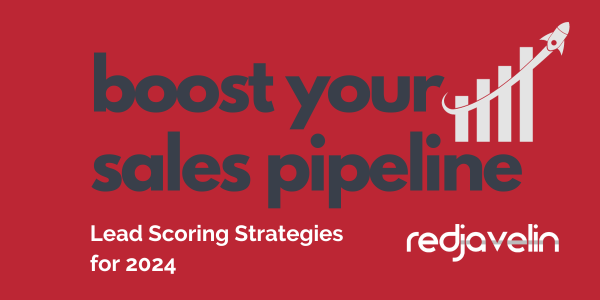 Here we are, cruising into yearend 2023. More than 66% of sales reps are expected to miss quota in 2023; some estimates expect this number to be more than 80%. (Sources: Bravado, QuotaPath, Zendesk) This happens for many reasons, but as marketers, one of our core objectives is to help increase sales. One way we can help is to bring focus to our sales and marketing efforts by lead scoring.
Here we are, cruising into yearend 2023. More than 66% of sales reps are expected to miss quota in 2023; some estimates expect this number to be more than 80%. (Sources: Bravado, QuotaPath, Zendesk) This happens for many reasons, but as marketers, one of our core objectives is to help increase sales. One way we can help is to bring focus to our sales and marketing efforts by lead scoring.
What is lead scoring?
Lead scoring is the process of assigning a numerical value to each contact in your CRM based on their level of interest and engagement with your brand. This helps you to identify and prioritize the most engaged contacts so that you can focus your sales and marketing efforts on prospects that are most likely to convert to customers.
Lead scoring can accelerate B2B sales in several ways:
- It helps sales teams to focus on the most qualified leads. By identifying the leads with the highest scores, sales teams can spend their time and resources on the leads most likely to convert, which leads to a significant increase in sales productivity and efficiency.
- It allows sales teams to prioritize their sales pipeline. With lead scoring, sales teams can easily identify the leads closest to making a purchase decision. This allows them to focus on these leads and close more deals quickly.
- It helps sales teams to identify leads that need to be nurtured further. Lead scoring can also help sales teams to identify the leads that are not yet ready to buy. These leads can be nurtured with targeted content and offers until they are ready to purchase. This can help to shorten the sales cycle and increase the overall conversion rate.
- By prioritizing your leads, you can avoid wasting time and resources on leads that are unlikely to convert. This will free up your sales team to focus on other tasks.
Setting Up a Lead Scoring System
Lead scoring can quickly become complex in B2B due to long sales cycles and the number of personas involved in the buying process. Because of this, you must have a documented plan on how you will score. Ensure the sales team is involved and buys into how you score. They need to determine when a prospect becomes a lead and when they want it handed off to them.
Here is a quick, simplified overview of how to set up a lead scoring system. We typically assign points on demographics and prospect behavior and remove points for negative items such as spam, people trying to sell you products and services, or giving bad email addresses.
Here is a generalized workflow for setting up a lead scoring system.
- Identify your ideal customer profile. What are their demographics, interests, and needs?
- Map out your buyer's journey. What steps do they go through before making a purchase?
- Identify the actions that your leads take that indicate interest and engagement. For example, visiting your website, downloading content, signing up for your email list, or attending a webinar. Don't limit this step to online activities. In some industries, in-person events are extremely important to the sales process. Sometimes it is the first encounter, but in other cases, prospects are stopping by for a demo. In each case, we assign points during the lead score process.
- Assign a score to each action—the more important the action, the higher the score.
- Use your lead scoring system to prioritize and target your leads with relevant content and offers.
Determining Lead Handoff
In HubSpot, we use lifecycle stages to determine whether a prospect is a lead, MQL (marketing qualified lead), or an SQL (sales qualified lead.) Once a prospect earns a certain number of points, they are assigned a lifecycle stage. For example, on a lead scoring system based on 100 points, a prospect with a lead score of 40 may be assigned lead status. They are just considered a prospect if they have less than 40 points. When they hit 70 points, they become an MQL; at 100 points, they become an SQL.
We use these designations to determine our tactics to move them to SQL. For example:
- You could identify the leads who attended your webinars and downloaded an ebook or white paper. These leads are assigned a medium score, as they are still learning about the company's services. We would consider these MQLs. You could develop a targeted email campaign to nurture these leads with additional content and offers until they are ready to schedule a consultation.
- You could identify the leads who visited their website and viewed or downloaded a pricing page. These leads are assigned a high score and are considered SQLs, as they are clearly interested in the company's product. The sales team then follows up with these leads immediately.
A Note About MQLs
There seems to be a lot of controversy around MQLs versus SQLs. Some B2Bs have overused or misinterpreted the significance of an MQL. At Red Javelin, we believe that an MQL is a measure of brand awareness. An MQL score is merely people engaging with top-of-funnel content – they have not entered the sales buying process. In comparison, an SQL measures someone who has entered the buying process and is actively looking for a solution.
When an MQL enters the buying cycle, your solutions will likely be shortlisted since the prospect knows your brand. We are huge proponents of spending budget on brand awareness—more on that in our next blog. If a prospect is unaware of your brand when they enter the buying cycle, it is unlikely that you will be shortlisted since up to 80% of the sales are completed online before speaking to a sales rep.
Lead Scoring = More Revenue and Better Efficiency
A solid lead scoring system can accelerate sales by creating more efficiencies for the sales team. Sales can focus on nurturing and closing high-value leads, while marketing can continue to educate prospects not yet in the buying cycle.
Lead scoring is essential for any business that wants to generate more revenue. By taking the time to implement a lead scoring system, you can improve your sales and marketing effectiveness and close more deals.




